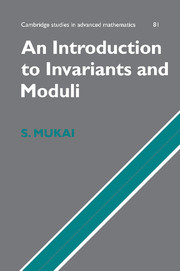Book contents
- Frontmatter
- Contents
- Preface
- Acknowledgements
- Introduction
- 1 Invariants and moduli
- 2 Rings and polynomials
- 3 Algebraic varieties
- 4 Algebraic groups and rings of invariants
- 5 The construction of quotient varieties
- 6 The projective quotient
- 7 The numerical criterion and some applications
- 8 Grassmannians and vector bundles
- 9 Curves and their Jacobians
- 10 Stable vector bundles on curves
- 11 Moduli functors
- 12 Intersection numbers and the Verlinde formula
- Bibliography
- Index
- References
4 - Algebraic groups and rings of invariants
Published online by Cambridge University Press: 05 February 2015
- Frontmatter
- Contents
- Preface
- Acknowledgements
- Introduction
- 1 Invariants and moduli
- 2 Rings and polynomials
- 3 Algebraic varieties
- 4 Algebraic groups and rings of invariants
- 5 The construction of quotient varieties
- 6 The projective quotient
- 7 The numerical criterion and some applications
- 8 Grassmannians and vector bundles
- 9 Curves and their Jacobians
- 10 Stable vector bundles on curves
- 11 Moduli functors
- 12 Intersection numbers and the Verlinde formula
- Bibliography
- Index
- References
Summary
In general it is hard to construct rings of invariants – that is, to determine explicitly a set of generators and relations. However, this is not actually necessary in order to say that a moduli space exists as an algebraic variety. For this one would like to understand – in the precise manner of a Galois theory, so to speak – the relationship between the invariant ideals in a ring and the ideals in its subring of invariants. What we need here is that the group that is acting is linearly reductive: this is the central notion in this chapter.
We begin by giving a careful definition of a representation of an algebraic group. Various important properties can be deduced only by following closely to this definition; for example, it allows us to deduce that all representations are locally finite-dimensional. The set of local distributions supported at the identity in an algebraic group G admits a convolution product, making it into a (noncommutative) algebra H(G), called the distribution algebra. The tangent space of G at the identity element, called the Lie spaceg = Lie G, is a vector subspace of H(G). As is well known, it inherits a Lie algebra structure, although we will not use this in this book. As well as the Lie space, H(G) also contains a distinguished element Ω, called the Casimir element, constructed using an invariant inner product on the Lie space (Section 4.2). In Section 4.3 we use the Casimir element to prove the linear reductivity of SL(n). We then prove Hilbert's Theorem 4.53 that if a linearly reductive algebraic group acts on a finitely generated algebra, then the invariant subalgebra is finitely generated. The key ingredient in the proof of this is Hilbert's Basis Theorem.
In Section 4.4 we determine the Hilbert series of the rings of classical binary invariants. Using the relation e ⋆ f − f ⋆ e = h in the distribution algebra, we prove the dimension formula for (invariants of) SL(2).
- Type
- Chapter
- Information
- An Introduction to Invariants and Moduli , pp. 116 - 157Publisher: Cambridge University PressPrint publication year: 2003

